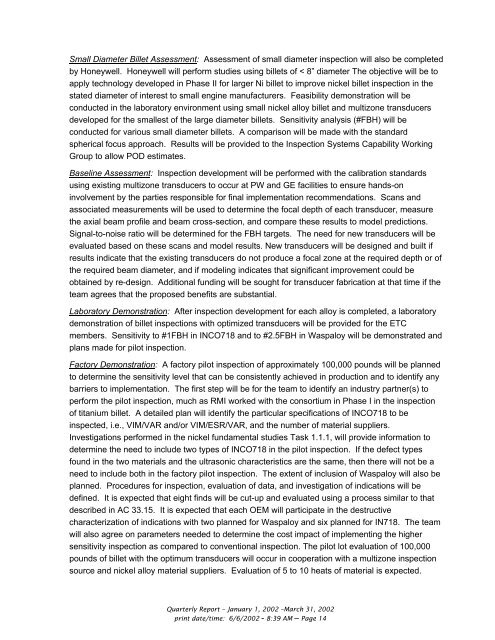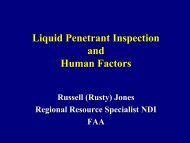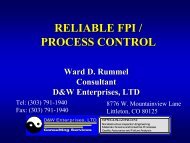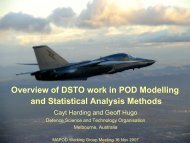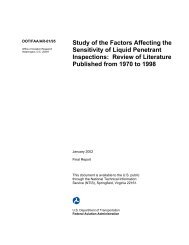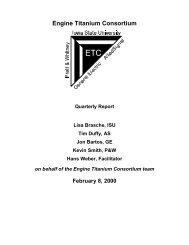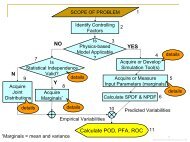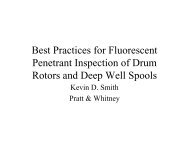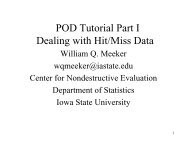Engine Titanium Consortium - Center for Nondestructive Evaluation ...
Engine Titanium Consortium - Center for Nondestructive Evaluation ...
Engine Titanium Consortium - Center for Nondestructive Evaluation ...
Create successful ePaper yourself
Turn your PDF publications into a flip-book with our unique Google optimized e-Paper software.
Small Diameter Billet Assessment: Assessment of small diameter inspection will also be completed<br />
by Honeywell. Honeywell will per<strong>for</strong>m studies using billets of < 8” diameter The objective will be to<br />
apply technology developed in Phase II <strong>for</strong> larger Ni billet to improve nickel billet inspection in the<br />
stated diameter of interest to small engine manufacturers. Feasibility demonstration will be<br />
conducted in the laboratory environment using small nickel alloy billet and multizone transducers<br />
developed <strong>for</strong> the smallest of the large diameter billets. Sensitivity analysis (#FBH) will be<br />
conducted <strong>for</strong> various small diameter billets. A comparison will be made with the standard<br />
spherical focus approach. Results will be provided to the Inspection Systems Capability Working<br />
Group to allow POD estimates.<br />
Baseline Assessment: Inspection development will be per<strong>for</strong>med with the calibration standards<br />
using existing multizone transducers to occur at PW and GE facilities to ensure hands-on<br />
involvement by the parties responsible <strong>for</strong> final implementation recommendations. Scans and<br />
associated measurements will be used to determine the focal depth of each transducer, measure<br />
the axial beam profile and beam cross-section, and compare these results to model predictions.<br />
Signal-to-noise ratio will be determined <strong>for</strong> the FBH targets. The need <strong>for</strong> new transducers will be<br />
evaluated based on these scans and model results. New transducers will be designed and built if<br />
results indicate that the existing transducers do not produce a focal zone at the required depth or of<br />
the required beam diameter, and if modeling indicates that significant improvement could be<br />
obtained by re-design. Additional funding will be sought <strong>for</strong> transducer fabrication at that time if the<br />
team agrees that the proposed benefits are substantial.<br />
Laboratory Demonstration: After inspection development <strong>for</strong> each alloy is completed, a laboratory<br />
demonstration of billet inspections with optimized transducers will be provided <strong>for</strong> the ETC<br />
members. Sensitivity to #1FBH in INCO718 and to #2.5FBH in Waspaloy will be demonstrated and<br />
plans made <strong>for</strong> pilot inspection.<br />
Factory Demonstration: A factory pilot inspection of approximately 100,000 pounds will be planned<br />
to determine the sensitivity level that can be consistently achieved in production and to identify any<br />
barriers to implementation. The first step will be <strong>for</strong> the team to identify an industry partner(s) to<br />
per<strong>for</strong>m the pilot inspection, much as RMI worked with the consortium in Phase I in the inspection<br />
of titanium billet. A detailed plan will identify the particular specifications of INCO718 to be<br />
inspected, i.e., VIM/VAR and/or VIM/ESR/VAR, and the number of material suppliers.<br />
Investigations per<strong>for</strong>med in the nickel fundamental studies Task 1.1.1, will provide in<strong>for</strong>mation to<br />
determine the need to include two types of INCO718 in the pilot inspection. If the defect types<br />
found in the two materials and the ultrasonic characteristics are the same, then there will not be a<br />
need to include both in the factory pilot inspection. The extent of inclusion of Waspaloy will also be<br />
planned. Procedures <strong>for</strong> inspection, evaluation of data, and investigation of indications will be<br />
defined. It is expected that eight finds will be cut-up and evaluated using a process similar to that<br />
described in AC 33.15. It is expected that each OEM will participate in the destructive<br />
characterization of indications with two planned <strong>for</strong> Waspaloy and six planned <strong>for</strong> IN718. The team<br />
will also agree on parameters needed to determine the cost impact of implementing the higher<br />
sensitivity inspection as compared to conventional inspection. The pilot lot evaluation of 100,000<br />
pounds of billet with the optimum transducers will occur in cooperation with a multizone inspection<br />
source and nickel alloy material suppliers. <strong>Evaluation</strong> of 5 to 10 heats of material is expected.<br />
Quarterly Report – January 1, 2002 –March 31, 2002<br />
print date/time: 6/6/2002 - 8:39 AM – Page 14


